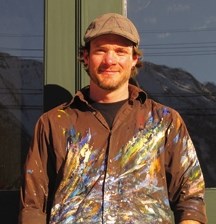A camera’s lens and a painter’s canvas show the transition across the great divide in a different light at the latest exhibit at the Okotoks Art Gallery at The Station.
Cranbrook photographer Neal Panton’s exhibit ‘Transitions’ will be featured in the large gallery, while Fernie artist Patrick Markle is bringing his exhibit ‘The Divide’ to the small gallery. The exhibits run at the Okotoks Art Gallery (OAG) at The Station from Aug. 3 to Sept. 2.
Panton’s first solo show in nine years explores transitions through landscapes, whether it’s from prairie to mountain, natural to developed, winter to spring and even oil and gas to wind energy.
“I’m interested in those relationships,” he said.
Many of the photos were taken in the Crowsnest Pass area.
It’s an area Panton is drawn to because he said it is unique among Alberta’s mountain communities with its abrupt transition from a landscape influenced by human activity to the natural world.
“When you come through the Crowsnest, you get a sense of people – that movement of people back and forth,” he said.
The exhibit also speaks to changes in Panton’s own life over the past decade. Panton is originally from Ontario and the exhibit is reminiscent of his own trip across the country when he moved out west 12 years ago and travelled through the foothills, including the Crowsnest Pass, on a trip from Vancouver to Saskatoon,.
“It really spoke about my own transition from different places,” said Panton.
He said most of the photos in the exhibit are of cultured landscapes that have been settled or adapted in some way or another.
“When I do landscapes, I seem to be drawn to these sparsely populated landscapes and I’m always really careful about not having anyone in them, it’s that evidence that there are people there,” he said.
The black and white photos have been treated to create a unique look with a lot of contrast. It’s a style he has developed after years of working in darkrooms developing his images.
Markle’s exhibits explores the mountains of his adopted B.C. and water scenes from his home province of Ontario.
“I really like trying to capture the volume of the mountains, for the mountainscapes,” he said. “I try to do either the form or structure of the mountains or I try to do waterscapes and play with the design using the texture of the water.”
The exhibit at OAG is Markles’ first solo show in Alberta.
As a landscape artist, he credited the Group of Seven (WHAT IS THE GROUP OF SEVEN? EXPLAIN THEY ARE ARTISTSXX) as an influence over his non-realist style. His background is as a printmaker and his training in block making transferred over to his paintings.
“It’s more of a post-impressionist style that focuses more on form and getting the spirit of the land rather than the exact appearance,” said Markle.




